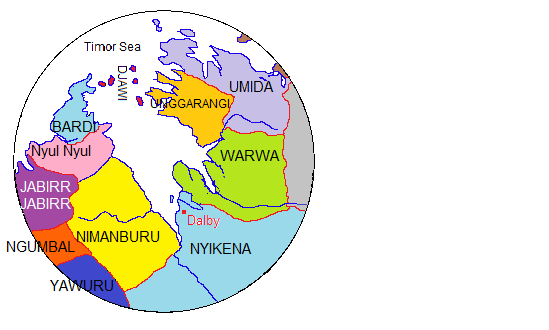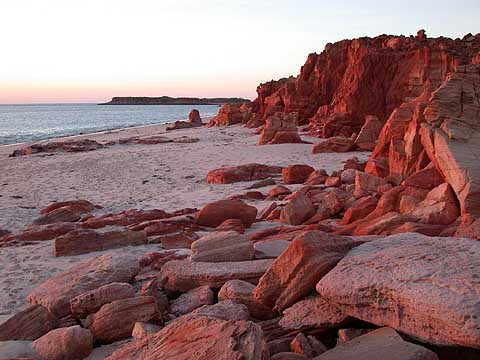|
Nimanburu Language
Nimanburru is an extinct Western Nyulnyulan language formerly spoken on the eastern shore of the Dampier Peninsula in the north-west of Australia. Archival records exist in the Australian Institute of Aboriginal and Torres Strait Islander Studies The Australian Institute of Aboriginal and Torres Strait Islander Studies (AIATSIS), established as the Australian Institute of Aboriginal Studies (AIAS) in 1964, is an independent Australian Government statutory authority. It is a collecting, ... and some of the material in Hermann Nekes and Ernest Ailred Worms' ''Australian Languages'' is from the language. References Nyulnyulan languages {{ia-lang-stub ... [...More Info...] [...Related Items...] OR: [Wikipedia] [Google] [Baidu] |
Australia
Australia, officially the Commonwealth of Australia, is a Sovereign state, sovereign country comprising the mainland of the Australia (continent), Australian continent, the island of Tasmania, and numerous List of islands of Australia, smaller islands. With an area of , Australia is the largest country by area in Oceania and the world's List of countries and dependencies by area, sixth-largest country. Australia is the oldest, flattest, and driest inhabited continent, with the least fertile soils. It is a Megadiverse countries, megadiverse country, and its size gives it a wide variety of landscapes and climates, with Deserts of Australia, deserts in the centre, tropical Forests of Australia, rainforests in the north-east, and List of mountains in Australia, mountain ranges in the south-east. The ancestors of Aboriginal Australians began arriving from south east Asia approximately Early human migrations#Nearby Oceania, 65,000 years ago, during the Last Glacial Period, last i ... [...More Info...] [...Related Items...] OR: [Wikipedia] [Google] [Baidu] |
Nimanburu
The Nimanburu were an Aboriginal Australian people of the Kimberley region of Western Australia. Language The Nimanburu language was one of the Nyulnyulan languages. Their speech was described by other aboriginal informants as a 'heavy' dialect of the language spoken by the Warrwa. Country Norman Tindale estimate Nimanburu tribal lands to extend over roughly from the King Sound coast, around Repulse Point southwards to the swamp plain where the Fraser River debouches into the sea. Their inland extension ran as far as the headwaters of that river. People Despite being territorially a coastal people, the Nimanburu refrained from seafaring, and were not known to employ rafts as other contiguous groups in the King Sound did. Alternative names * ''Nimanboro, Nimanbur, Ninambur.'' * ''Wadiabulu.'' (Nyigina exonym An endonym (from Greek: , 'inner' + , 'name'; also known as autonym) is a common, ''native'' name for a geographical place, group of people, individual person, ... [...More Info...] [...Related Items...] OR: [Wikipedia] [Google] [Baidu] |
Nyulnyulan Languages
The Nyulnyulan languages are a small family of closely related Australian Aboriginal languages spoken in northern Western Australia. Most languages in this family are extinct, with only three extant languages, all of which are almost extinct. Internal classification The languages form two branches established on the basis of lexical and morphological innovation. * Western or Nyulnyulic: :: Nyulnyul † :: Bardi :: Jawi :: Djabirr-Djabirr † :: Nimanburru † * Eastern or Dyukun: ::Yawuru :: Dyugun † :: Warrwa † ::Nyigina :: Ngumbarl † Vocabulary Capell Capell or Capel is a surname. Notable people with the name include: Capell * Arthur Capell, 1st Baron Capell of Hadham (1608–1649), English politician * Arthur Capell, 1st Earl of Essex (1631–1683), English statesman * Arthur Capell (1902–1 ... (1940) lists the following basic vocabulary items for the Nyulnyulan languages:Capell, Arthur. 1940The Classification of Languages in North and North-West Australia ''Ocea ... [...More Info...] [...Related Items...] OR: [Wikipedia] [Google] [Baidu] |
Western Nyulnyulan Languages
The Nyulnyulan languages are a small family of closely related Australian Aboriginal languages spoken in northern Western Australia. Most languages in this family are extinct, with only three extant languages, all of which are almost extinct. Internal classification The languages form two branches established on the basis of lexical and morphological innovation. * Western or Nyulnyulic: :: Nyulnyul † :: Bardi :: Jawi :: Djabirr-Djabirr † ::Nimanburru † * Eastern or Dyukun: ::Yawuru :: Dyugun † ::Warrwa † ::Nyigina :: Ngumbarl † Vocabulary Capell (1940) lists the following basic vocabulary items for the Nyulnyulan languages:Capell, Arthur. 1940The Classification of Languages in North and North-West Australia ''Oceania'' 10(3): 241-272, 404-433. : Lexical isoglosses Some lexical isogloss An isogloss, also called a heterogloss (see Etymology below), is the geographic boundary of a certain linguistic feature, such as the pronunciation of a vowel, the meaning of a ... [...More Info...] [...Related Items...] OR: [Wikipedia] [Google] [Baidu] |
Dampier Peninsula
The Dampier Peninsula is a peninsula located north of Broome and Roebuck Bay in Western Australia. It is surrounded by the Indian Ocean to the west and north, and King Sound to the east. It is named after the mariner and explorer William Dampier who visited it. The northernmost part of the peninsula is Cape Leveque. It is sparsely inhabited, mostly by Indigenous Australian peoples, some of whom have been granted native title rights to some of their traditional lands. There are many coastal inlets, bays and other features, including Beagle Bay on its western side. Aboriginal heritage The peninsula is home to a rich heritage of Aboriginal culture, with the communities of Beagle Bay, Bobieding, Djarindjin, Ardyaloon (One Arm Point) and Ngardalargin, along with numerous other smaller communities, pearling camps, tourist resorts and Aboriginal outstations. The traditional owners of the areas around the peninsula are the Bardi, Nyunyul and Jabirr Jabirr (Djaberadjabera) peo ... [...More Info...] [...Related Items...] OR: [Wikipedia] [Google] [Baidu] |
Australian Institute Of Aboriginal And Torres Strait Islander Studies
The Australian Institute of Aboriginal and Torres Strait Islander Studies (AIATSIS), established as the Australian Institute of Aboriginal Studies (AIAS) in 1964, is an independent Australian Government statutory authority. It is a collecting, publishing and research institute and is considered to be Australia's premier resource for information about the cultures and societies of Aboriginal and Torres Strait Islander peoples. The institute is a leader in ethical research and the handling of culturally sensitive material'Aboriginal and Torres Strait Islander Library, Information and Resource Network (ATSILIRN) Protocols for Libraries, Archives and Information Services', http://atsilirn.aiatsis.gov.au/protocols.php, retrieved 12 March 2015‘'AIATSIS Collection Development Policy 2013 – 2016'’, AIATSIS website, http://aiatsis.gov.au/sites/default/files/docs/about-us/collection-development-policy.pdf, retrieved 12 March 2015 and holds in its collections many unique and irrepla ... [...More Info...] [...Related Items...] OR: [Wikipedia] [Google] [Baidu] |
Ernest Ailred Worms
Ernest Ailred Worms (1891-1963) was a German missionary who lived and worked among Indigenous Australians. He became an expert in Aboriginal languages, and an important contributor to the development of both Australian studies of native languages, and to the ethnography of the continent's Indigenous peoples. Life He was ordained a Pallotine father, and spent his first period of missionary work in Broome, where he served as parish priest for eight years. His interest in ethnography led to particular studies among the Bardi people. Stolen bones In 1935 Worms came across the large body of an Aboriginal person wrapped for burial in bark and, as was a widespread custom, placed in the fork of a tree. He gathered the remains and dispatched them to Limburg. Worms was quite aware that he was violating the law against the unauthorised export of ethnological materials in doing so, and therefore requested anonymity. The remains, together with other skeletal material, was repatriated ... [...More Info...] [...Related Items...] OR: [Wikipedia] [Google] [Baidu] |
Traditional Lands Of Australian Aboriginal Tribes Around Derby
A tradition is a belief or behavior (folk custom) passed down within a group or society with symbolic meaning or special significance with origins in the past. A component of cultural expressions and folklore, common examples include holidays or impractical but socially meaningful clothes (like lawyers' wigs or military officers' spurs), but the idea has also been applied to social norms such as greetings. Traditions can persist and evolve for thousands of years—the word ''tradition'' itself derives from the Latin ''tradere'' literally meaning to transmit, to hand over, to give for safekeeping. While it is commonly assumed that traditions have an ancient history, many traditions have been invented on purpose, whether that be political or cultural, over short periods of time. Various academic disciplines also use the word in a variety of ways. The phrase "according to tradition", or "by tradition", usually means that whatever information follows is known only by oral tradition ... [...More Info...] [...Related Items...] OR: [Wikipedia] [Google] [Baidu] |


